
Bhakra Nangal Dam is a concrete gravity dam on the Satluj River in Bhakra Village in Bilaspur district, Himachal Pradesh in northern India. The dam forms the Gobind Sagar reservoir. Nangal Dam is another dam at Nangal in Punjab downstream of Bhakra Dam. However, sometimes both the dams together are called Bhakra-Nangal Dam though they are two separate dams.

Ghazi-Barotha Hydropower Project is a 1,450 MW run-of-the-river hydropower, connected to the Indus River. It is located about 10 km (6.2 mi) west of Attock in the Punjab province and east of Haripur in the Khyber Pakhtunkhwa province of Pakistan. Construction of the project began in 1995. It consists of five generators, each possessing a maximum power generation capacity of 290 MW. The inauguration of the plant took place on 19 August 2003, presided over by the then President General Pervez Musharraf. It also saw the commissioning of the first two of the five generators i.e. Unit 1 and Unit 2. The last generator was commissioned on 6 April, 2004, and the project was completed by December the same year. It costed US$2.1 billion with funding from Pakistan's Water and Power Development Authority, the World Bank, Asian Development Bank, Japan Bank for International Cooperation, Kreditanstalt für Wiederaufbau, European Investment Bank and Islamic Development Bank.
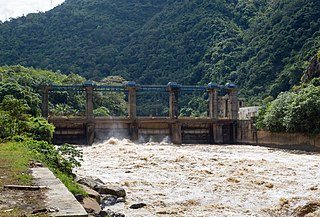
Tenom Pangi Dam is a hydroelectric plant in Tenom, Sabah, Malaysia. It is located 120 km (75 mi) south of Kota Kinabalu on the Padas River. The project is a run-of-river hydroelectric power plant. Tenom Pangi Dam is the only major hydroelectric dam in Sabah.

The Tokuyama Dam is an embankment dam near Ibigawa, Ibi District, Gifu Prefecture in Japan. The dam was completed in 2008 and will support a 153 MW hydroelectric power station that is expected to be fully operational in 2015. Unit 1 at 23 MW was commissioned in May 2014. The dam was originally intended to withhold the upper reservoir of a 400 MW pumped-storage power station until a design change in 2004. The dam is also intended for flood control and water supply. It is the largest dam by structural volume in Japan and withholds the country's largest reservoir by volume as well.
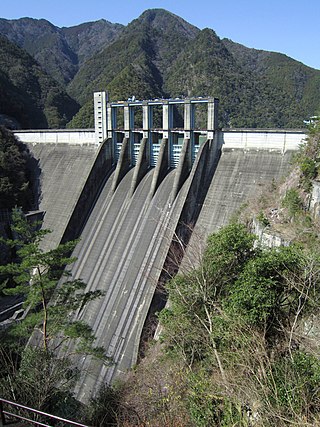
The Sakuma Dam is a dam on the Tenryū River, located on the border of Toyone, Kitashitara District, Aichi Prefecture on the island of Honshū, Japan. It is one of the tallest dams in Japan and supports a 350 MW hydroelectric power station. Nearby a frequency converter station is installed, allowing interchange of power between Japan's 50 Hz and 60 Hz AC networks.

The Maruyama Dam is a dam on the border of Mitake and Yaotsu in Gifu Prefecture, Japan. It was built on the upper reaches of the Kiso River system. It is a gravity dam that is 98.2 m (322 ft) tall. It is the site of a power plant.

Shimohara Dam is a dam in the city of Gero, Gifu Prefecture, Japan on the middle reaches of the Hida River, which is part of the Kiso River system. The dam is a concrete gravity dam with a height of 23.0 meters. It was completed in 1938 by the Toho Electric Power Company as part of the pre-war Hida River Development Project and was taken over by the Chubu Electric Power Company from 1951. The dam was constructed exclusively for hydroelectric power generation and generates a maximum of 22,000 kilowatts at the Shimohara Power Station downstream of the dam. The dam is located with the borders of the Hida-Kisogawa Quasi-National Park.
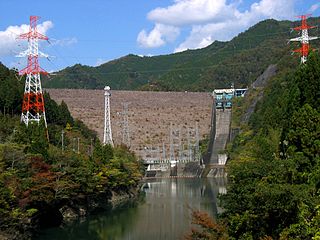
The Iwaya Dam is a dam in the city of Gero, Gifu Prefecture, Japan on the Maze River, part of the Kiso River system. The dam is a rockfill dam with a height of 127 meters and was constructed as a multipurpose dam for flood control, supply of municipal and industrial water, irrigation water and hydroelectric power generation. The reservoir created by the dam supplies the Chubu Electric Power Company's Mazegawa No.1 Power plant with a capacity of 288 MW hydroelectric power station.
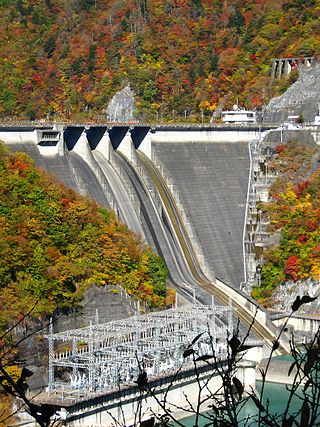
The Hatanagi-I is a dam on the Ōi River in Aoi-ku, Shizuoka, Shizuoka Prefecture on the island of Honshū, Japan. With a height of 125 metres (410 ft), it is the tallest hollow-core concrete gravity dam in the world. It has a hydroelectric power generating station owned by the Chubu Electric Power Company. It supports a 137 megawatts (184,000 hp) pumped-storage hydroelectric power station.

The Hatanagi-II is a dam on the Ōi River in Aoi-ku, Shizuoka, Shizuoka Prefecture on the island of Honshū, Japan. A hollow-core concrete gravity dam, it has a hydroelectric power generating station owned by the Chubu Electric Power Company.

The Miho Dam is a multi-purpose dam on the Kawauchi River, a tributary stream of the Sakawa River in the town of Yamakita, Ashigarakami District, Kanagawa Prefecture on the island of Honshū, Japan. The dam is located within the borders of the Tanzawa-Ōyama Quasi-National Park.

The Upper Kotmale Dam is located in Talawakele, within the Nuwara Eliya District, in the Central Province of Sri Lanka. The dam feeds the third largest hydroelectric power station in the country.

Gosho Dam is a multipurpose dam on the Shizukuishi River, a branch of the Kitakami River in Morioka, Iwate Prefecture, Japan, completed in 1981.
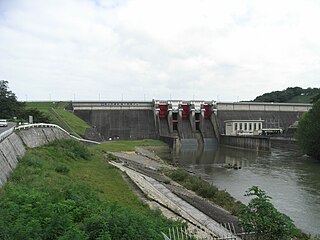
The Shijūshida Dam is a dam on the Kitakami River, located in Morioka, Iwate Prefecture on the island of Honshū, Japan.
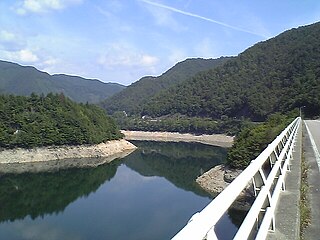
The Maze River is a river in Japan which originates in Takayama, Gifu. It flows through Gero before emptying into the Hida River. Due to its clear waters, it is home to the Japanese giant salamander.

Tsukabaru Dam is a concrete gravity dam built on the Mimi River for hydro-electric power generation in the Miyazaki Prefecture in Japan. The dam, built by the Kyushu Electric Power Co, Ltd. in 1938, was commissioned only in 1993. When built to a height of 87 m (285 ft) it was the highest gravity type dam in Japan, only to be surpassed later by the Kamishiba Dam raised in the uppermost reaches of the Mimi River.

The Okutadami Dam (奥只見ダム) is a concrete gravity dam on the Tadami River, 26 km (16 mi) east of Uonuma on the border of Niigata and Fukushima Prefectures, Japan. The primary purpose of the dam is hydroelectric power generation and it supports a 560 MW power station which is the largest conventional hydroelectric power station in Japan. The dam also forms the second largest reservoir in Japan, next to that of the Tokuyama Dam.

The Otori Dam is a concrete arch-gravity dam on the Tadami River, 17 km (11 mi) southwest of Tadami in Fukushima Prefecture, Japan. The primary purpose of the dam is hydroelectric power generation and it supports a 182 MW power station. The power station contains two Kaplan turbine-generators. Unit 1 was commissioned on 20 November 1963 while Unit 2 was commissioned on 7 June 2003 as part of a power plant expansion project that included an additional 200 MW generator at Okutadami Dam upstream. The dam is 83 m (272 ft) tall and 188 m (617 ft) long. Its reservoir has a 15,800,000 m3 (12,809 acre⋅ft) capacity of which 5,000,000 m3 (4,054 acre⋅ft) is active for power generation. The reservoir has a catchment area of 656.9 km2 (254 sq mi) and surface area of 89 ha. Of the two generators, Unit 1 has a maximum effective hydraulic head of 50.8 m (167 ft) and Unit 2 is afforded 48.1 m (158 ft). The design flood discharge of the dam is 2,200 m3/s (77,692 cu ft/s) and its service spillway is controlled by three tainter gates.
The Boyabat Dam is a concrete gravity dam on the Kızılırmak River bordering Sinop and Samsun Provinces, Turkey. It is 8 km (5 mi) southwest of Durağan and 24 km (15 mi) southeast of Boyabat. Construction began in 2008 and the dam and power plant were completed in December 2012. Its primary purpose is to generate hydroelectric power. The dam's power plant has an installed capacity of 513 MW.
The Kukule Ganga Dam is a 110 m (360 ft) gravity dam built across the Kukule River in Kalawana, Sri Lanka. The run-of-river dam feeds an underground hydroelectric power station located approximately 5 kilometres (3.1 mi) away, via tunnel.



















